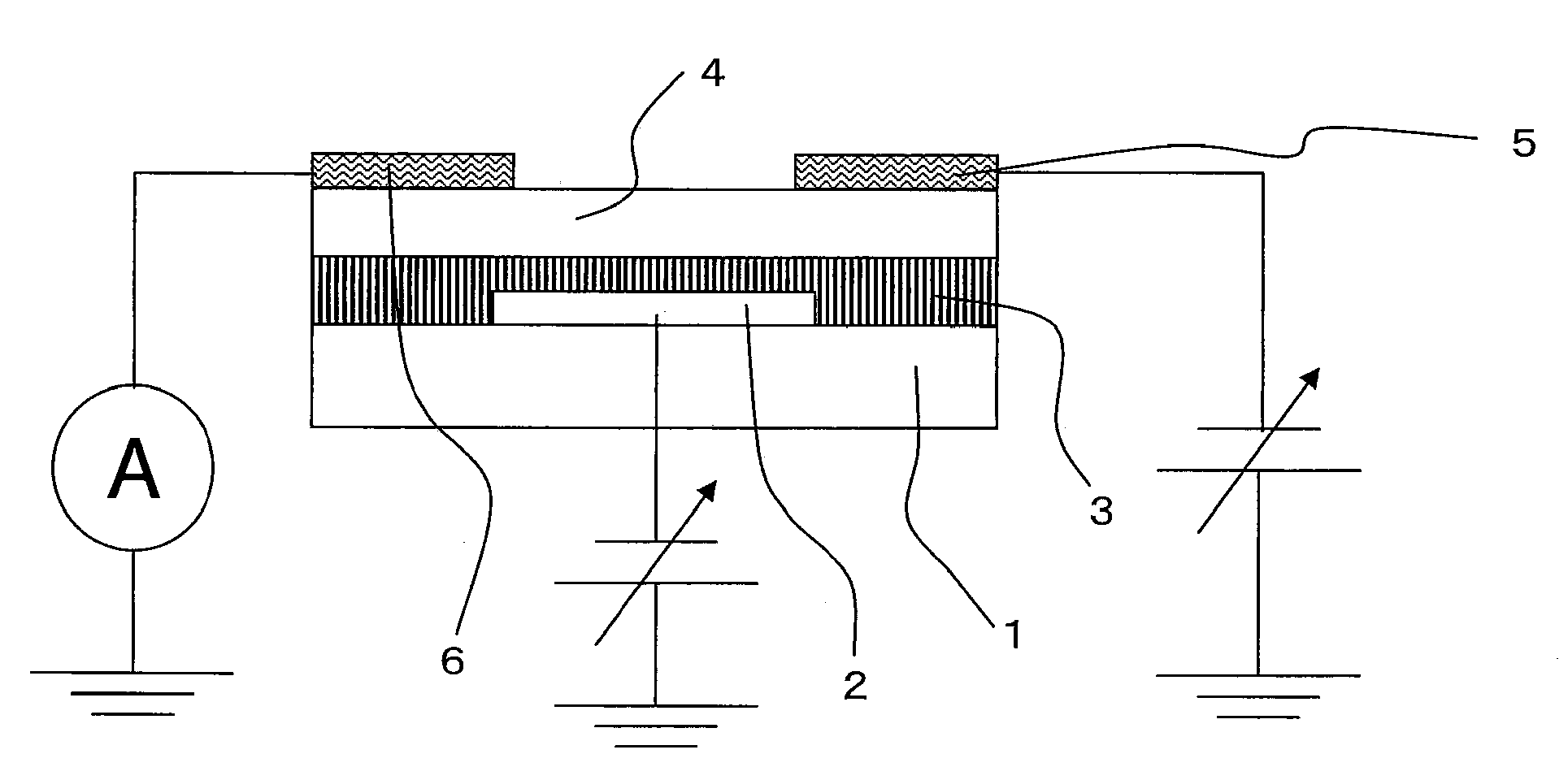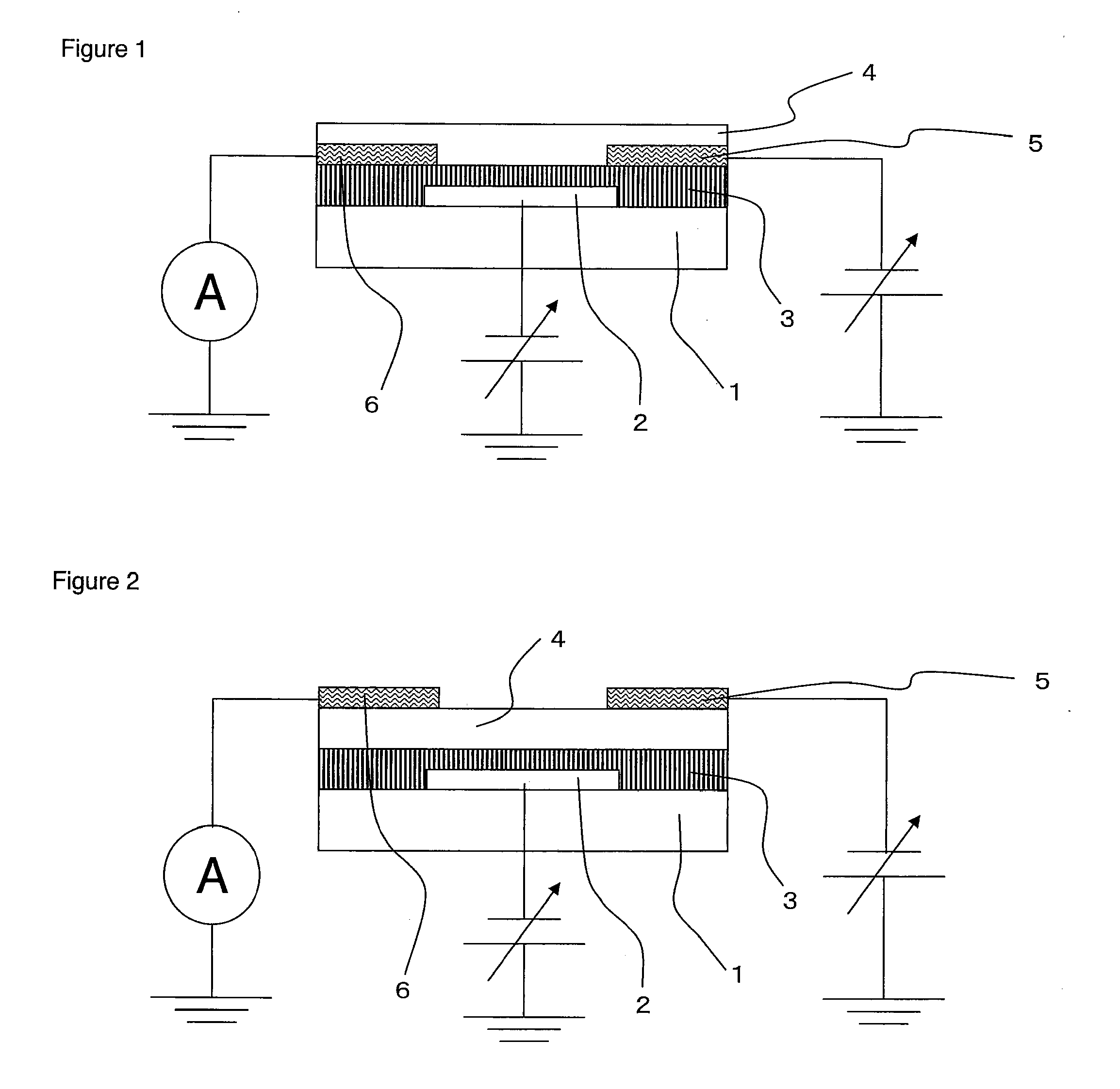Gate insulating material, gate insulating film and organic field-effect transistor
a gate insulating film and organic field-effect technology, applied in the field of gate insulating film and organic field-effect transistor, can solve the problems of high temperature process, inorganic film formation is difficult, and inorganic film coating is not easy to achieve, and the effect of superior chemical resistance and coatability of resists
- Summary
- Abstract
- Description
- Claims
- Application Information
AI Technical Summary
Benefits of technology
Problems solved by technology
Method used
Image
Examples
example 1
(1) Preparation of Organic Semiconductor Composite Solution
[0117]0.10 g of poly(3-hexyl thiophene) (manufactured by Aldrich, regioregular, number average molecular weight (Mn): 13000, hereinafter referred to as P3HT) as a conjugated polymer was added to 5 ml of chloroform in a flask and the resulting mixture was mixed by ultrasonic agitation in an ultrasonic cleaner (US-2 manufactured by Iuchi Seieido Co., Ltd., output 120 W) to obtain a chloroform solution of P3HT. Next, this solution was taken with a dropper and added dropwise to a mixed solution of 20 ml of methanol and 10 ml of 0.1 N hydrochloric acid in 0.5 ml portions to perform reprecipitation. The solidified P3HT was collected through filtration by a membrane filter (manufactured by PTFE Co.: ethylene tetrafluoride) with a pore size of 0.1 μm and adequately rinsed with methanol, and then the solvent was eliminated by vacuum-drying. Dissolution and reprecipitation were repeated once more to obtain 90 mg of reprecipitated P3HT...
example 2
[0126]95.3 g (0.7 mol) of MTMSi, 24.6 g (0.1 mol) of β-EpETMSi and 39.7 g (0.2 mol) of PhTMSi were dissolved in 183 g of PGMB, and to the resulting solution, 55.8 g of water and 0.80 g of phosphoric acid were added while stirring the solution. The internal temperature of the resulting solution was raised to 90° C. by heating the solution in a bath of 105° C. for 2 hours to distill off components predominantly composed of methanol as a by-product. Next, the internal temperature of the solution was raised to 118° C. by heating the solution in a bath of 130° C. for 2 hours to distill off components predominantly composed of water and then the solution was cooled to room temperature to obtain a polysiloxane B having a solid concentration of 28.0% by weight. 50.0 g of the polysiloxane B obtained was weighed out and to this, 0.40 g of zirconia tetrakis(acetylacetonate) (hereinafter, referred to as ZrAcAc) as a zirconia-based curing agent was added, and the resulting mixture was mixed with...
example 3
[0127]40.9 g (0.3 mol) of MTMSi, 73.8 g (0.3 mol) of β-EpETMSi and 79.3 g (0.4 mol) of PhTMSi were dissolved in 231 g of propylene glycol monopropyl ether (boiling point 150° C., hereinafter, referred to as PGMP), and to the resulting solution, 59.4 g of water and 0.59 g of phosphoric acid were added while stirring the solution. The internal temperature of the resulting solution was raised to 90° C. by heating the solution in a bath of 105° C. for 2 hours to distill off components predominantly composed of methanol as a by-product. Next, the internal temperature of the solution was raised to 118° C. by heating the solution in a bath of 140° C. for 2 hours to distill off components predominantly composed of water and then the solution was cooled to room temperature to obtain a polysiloxane C having a solid concentration of 24.3% by weight. 50.0 g of the poly siloxane C obtained was weighed out and to this, 0.60 g of magnesium bis(acetylacetonate) (trade name NACEM magnesium, manufact...
PUM
| Property | Measurement | Unit |
|---|---|---|
| pressure | aaaaa | aaaaa |
| boiling point | aaaaa | aaaaa |
| temperature | aaaaa | aaaaa |
Abstract
Description
Claims
Application Information
 Login to View More
Login to View More - R&D
- Intellectual Property
- Life Sciences
- Materials
- Tech Scout
- Unparalleled Data Quality
- Higher Quality Content
- 60% Fewer Hallucinations
Browse by: Latest US Patents, China's latest patents, Technical Efficacy Thesaurus, Application Domain, Technology Topic, Popular Technical Reports.
© 2025 PatSnap. All rights reserved.Legal|Privacy policy|Modern Slavery Act Transparency Statement|Sitemap|About US| Contact US: help@patsnap.com



